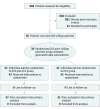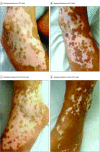Combination of Follicular and Epidermal Cell Suspension as a Novel Surgical Approach in Difficult-to-Treat Vitiligo: A Randomized Clinical Trial
- PMID: 29387874
- PMCID: PMC5885825
- DOI: 10.1001/jamadermatol.2017.5795
Combination of Follicular and Epidermal Cell Suspension as a Novel Surgical Approach in Difficult-to-Treat Vitiligo: A Randomized Clinical Trial
Abstract
Importance: Epidermal cell suspension (ECS) and follicular cell suspension (FCS) are successful surgical modalities for the treatment of stable vitiligo. However, repigmentation in generalized and acrofacial vitiligo and over acral or bony sites (eg, elbows, knees, iliac crests, and malleoli), which are difficult to treat, is challenging.
Objective: To study the efficacy of transplanting a combination of autologous, noncultured ECS and FCS (ECS + FCS) compared with ECS alone in stable vitiligo.
Design, setting, and participants: A prospective, observer-blinded, active-controlled, randomized clinical trial was conducted at a tertiary care hospital, with treatment administered as an outpatient procedure. Thirty participants who had stable vitiligo with symmetrical lesions were recruited between October 18, 2013, and October 28, 2016. All of the lesions were resistant to medical modalities with minimum lesional stability of 1 year. Intent-to-treat analysis was used.
Interventions: ECS + FCS was prepared by mixing equal amounts (in cell number) of FCS with ECS. After manual dermabrasion, ECS was applied to 1 lesion and ECS + FCS was applied to the anatomically based paired lesion of the same patient. No adjuvant treatment was given.
Main outcomes and measures: Patients were followed up at 4, 8, and 16 weeks by a blinded observer and extent of repigmentation, color match, pattern of repigmentation, patient satisfaction and complications were noted. Both the visual and the computerized image analysis methods were used for outcome assessment. Cell suspensions were assessed post hoc for OCT4+ stem cell counts using flow cytometry; expression of stem cell factor and basic fibroblast growth factor was evaluated using quantitative relative messenger RNA expression.
Results: Of the 30 patients included in the study, 18 (60%) were women; mean (SD) age was 23.4 (6.4) years. Seventy-four percent of the lesions (62 of 84) were difficult-to-treat vitiligo. ECS + FCS showed superior repigmentation outcomes compared with ECS: extent (76% vs 57%, P < .001), rapidity (48% vs 31%, P = .001), color match (73% vs 61%, P < .001), and patient satisfaction (mean [SD] patient global assessment score, 23.30 [6.89] vs 20.81 [6.61], P = .047). Melanocyte stem cell counts (2% in ECS + FCS vs 0.5% in ECS) as well as expression of basic fibroblast growth factor (11.8-fold) and stem cell factor (6.0-fold) were higher in ECS + FCS suspension (P<.05 for both).
Conclusions and relevance: The findings from this study establish ECS + FCS as a novel approach in vitiligo surgery for attaining good to excellent repigmentation in a short period with good color match, even in difficult-to-treat vitiligo.
Trial registration: ctri.nic.in Identifier: CTRI/2017/05/008692.
Conflict of interest statement
Figures


Similar articles
-
Efficacy of Transplantation of Combination of Noncultured Dermal and Epidermal Cell Suspension vs Epidermal Cell Suspension Alone in Vitiligo: A Randomized Clinical Trial.JAMA Dermatol. 2019 Feb 1;155(2):204-210. doi: 10.1001/jamadermatol.2018.4919. JAMA Dermatol. 2019. PMID: 30601885 Free PMC article. Clinical Trial.
-
Four compartment method as an efficacious and simplified technique for autologous non-cultured epidermal cell suspension preparation in vitiligo surgery: A randomized, active-controlled study.J Eur Acad Dermatol Venereol. 2019 Jan;33(1):185-190. doi: 10.1111/jdv.15234. Epub 2018 Sep 25. J Eur Acad Dermatol Venereol. 2019. PMID: 30176093 Clinical Trial.
-
A prospective, randomized clinical study to compare the efficacy of recipient site preparation using dermabrasion, cryoblister, and dermaroller in autologous noncultured epidermal cell suspension in stable vitiligo.Dermatol Ther. 2021 Jan;34(1):e14683. doi: 10.1111/dth.14683. Epub 2020 Dec 27. Dermatol Ther. 2021. PMID: 33340229 Clinical Trial.
-
Surgical Interventions for Patients With Vitiligo: A Systematic Review and Meta-analysis.JAMA Dermatol. 2021 Mar 1;157(3):307-316. doi: 10.1001/jamadermatol.2020.5756. JAMA Dermatol. 2021. PMID: 33595599 Free PMC article.
-
Surgical approaches for stable vitiligo.Dermatol Surg. 2005 Oct;31(10):1277-84. doi: 10.1111/j.1524-4725.2005.31203. Dermatol Surg. 2005. PMID: 16188179 Review.
Cited by
-
Management of the refractory vitiligo patient: current therapeutic strategies and future options.Front Immunol. 2024 Jan 4;14:1294919. doi: 10.3389/fimmu.2023.1294919. eCollection 2023. Front Immunol. 2024. PMID: 38239366 Free PMC article. Review.
-
Management of Stable Vitiligo-A Review of the Surgical Approach.J Clin Med. 2023 Mar 2;12(5):1984. doi: 10.3390/jcm12051984. J Clin Med. 2023. PMID: 36902772 Free PMC article. Review.
-
A Systematic Review of Case Series and Clinical Trials Investigating Regenerative Medicine for the Treatment of Vitiligo.J Cosmet Dermatol. 2025 Feb;24(2):e16660. doi: 10.1111/jocd.16660. Epub 2024 Nov 7. J Cosmet Dermatol. 2025. PMID: 39509558 Free PMC article.
-
Autologous non-cultured melanocyte-keratinocyte transplantation in the treatment of vitiligo: patient selection and perspectives.Clin Cosmet Investig Dermatol. 2018 Oct 26;11:521-540. doi: 10.2147/CCID.S151503. eCollection 2018. Clin Cosmet Investig Dermatol. 2018. PMID: 30464567 Free PMC article. Review.
-
Differentiation of adipose-derived stem cells to functional CD105neg CD73low melanocyte precursors guided by defined culture condition.Stem Cell Res Ther. 2019 Aug 9;10(1):249. doi: 10.1186/s13287-019-1364-0. Stem Cell Res Ther. 2019. PMID: 31399041 Free PMC article.
References
-
- Holla AP, Parsad D. Vitiligo surgery: its evolution as a definite treatment in the stable vitiligo. G Ital Dermatol Venereol. 2010;145(1):79-88. - PubMed
-
- Mulekar SV, Isedeh P. Surgical interventions for vitiligo: an evidence-based review. Br J Dermatol. 2013;169(suppl 3):57-66. - PubMed
-
- Kim JY, Park CD, Lee JH, Lee CH, Do BR, Lee AY. Co-culture of melanocytes with adipose-derived stem cells as a potential substitute for co-culture with keratinocytes. Acta Derm Venereol. 2012;92(1):16-23. - PubMed
-
- Razmi T M, Parsad D, Kumaran SM. Combined epidermal and follicular cell suspension as a novel surgical approach for acral vitiligo. J Am Acad Dermatol. 2017;76(3):564-567. - PubMed
Publication types
MeSH terms
Substances
LinkOut - more resources
Full Text Sources
Other Literature Sources
Medical

